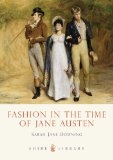-
History of:
- Resources about:
- More:
- Baby walkers
- Bakehouses
- Bed warmers
- Beer, ale mullers
- Besoms, broom-making
- Box, cabinet, and press beds
- Butter crocks, coolers
- Candle snuffers, tallow
- Clothes horses, airers
- Cooking on a peat fire
- Drying grounds
- Enamel cookware
- Fireplaces
- Irons for frills & ruffles
- Knitting sheaths, belts
- Laundry starch
- Log cabin beds
- Lye and chamber-lye
- Mangles
- Marseilles quilts
- Medieval beds
- Rag rugs
- Rushlights, dips & nips
- Straw mattresses
- Sugar cutters - nips & tongs
- Tablecloths
- Tinderboxes
- Washing bats and beetles
- Washing dollies
- List of all articles
Subscribe to RSS feed or get email updates.
The effect of a crisp highly-starched muslin dress upon a man of quick emotions is rapid and startling. The first impulse is to crush it between the arms, and crumple it up like a silverpaper balloon; but such desires cannot be indulged without the excuse of an affectionate embrace sanctioned by the parents of the young lady.
Is it not beautiful to gaze on the female form, clouded in fluttering gauze, and floating over the ground white and aerial as a puff of steam? Through the transparent skirt the embroidered petticoat displays its costly work, and the machinery of the little feet may be watched as under a glass-case, with increasing interest. The shoulders are seen through the slight haze of the bodice, and they are delicately fair.
Augustus Mayhew, Faces for Fortunes, 1865
Fashion in the Time of Jane Austen by Sarah Downing, from Amazon.comor Amazon UK

Anne Barker, The complete servant maid c1770, from Amazon.comor Amazon UK

Starched muslin
How did a laundress starch muslin?
 White muslin dresses, 18th and 19th century
style, were often described as "simple". Compared with expensive silks and satins,
they were indeed simple (particularly suitable for young women and girls?) but they
were certainly not simple for the person doing the laundry. A detailed explanation
(below) from c1770 shows all too well how much work went into keeping them white,
with texture and shape given by skilled starching and ironing. And it was not just
dresses. Remember the frilled caps, bonnets, children's clothes, ruffles on daywear
and nightwear etc.
White muslin dresses, 18th and 19th century
style, were often described as "simple". Compared with expensive silks and satins,
they were indeed simple (particularly suitable for young women and girls?) but they
were certainly not simple for the person doing the laundry. A detailed explanation
(below) from c1770 shows all too well how much work went into keeping them white,
with texture and shape given by skilled starching and ironing. And it was not just
dresses. Remember the frilled caps, bonnets, children's clothes, ruffles on daywear
and nightwear etc.
 Instructions for starching muslin always discuss "clapping" and "clearing" - essential
for a "natural" look free of excess starch: avoiding a clogged-up texture with traces
of starch stuck in the weave, or clinging to the surface. Muslin and other delicate
fabrics required "clear starching". Milky mixtures used on shirts and linens would
not do. A brief but straightforward explanation from 1845 says:
Instructions for starching muslin always discuss "clapping" and "clearing" - essential
for a "natural" look free of excess starch: avoiding a clogged-up texture with traces
of starch stuck in the weave, or clinging to the surface. Muslin and other delicate
fabrics required "clear starching". Milky mixtures used on shirts and linens would
not do. A brief but straightforward explanation from 1845 says:
What is called clear starching is the starching of laces, muslins, and other transparent tissues, which requires to be done with peculiar care; for these the starch is made thicker and hotter than ordinary, and the articles, after having been well washed, rinsed, and dried, are dipped into the thick starch, previously strained, before it is quite cold. After squeezing them out, they are clapped between the hands, to produce clearness. Instead of clapping, which is apt to injure lace, some prefer, after starching and squeezing out, spreading them on a linen cloth, rolling them up in it, and letting them ie for an hour, when they will be ready for the irons. Muslins and cambrics do not require the starch so thick as net or lace.
Webster and Parkes, Encyclopedia of Domestic Economy, 1845
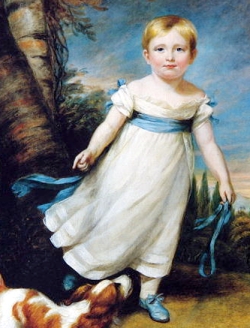 And now for the full method, as explained around 1770 in
The complete servant maid: or young woman's best companion
And now for the full method, as explained around 1770 in
The complete servant maid: or young woman's best companion,
by Mrs. Anne Barker, "who having for many years discharged the office of housekeeper
in the most respectable families, wishes to communicate her experience to those
of her own sex, whose circumstances oblige them to live in servitude".
To rinse Muslins before you starch them
 Take a cup of powder blue and mix it with some
pump water in a clean pan; when you have shaken it about for some time till it is
properly mixed, then put to it a cup more of cold pump water, and squeeze your muslins
through it one by one, never putting more than one in at a time, otherwise you will
be apt to spoil them by giving them a yellowish colour. If the remains of the blue
settle upon them, rub them in the water with your hand very slightly, but if any
of them appear yellow, you must put more blue to the water, as the only means of
making them change their colour. When you have rinsed them clean, let them be squeezed
as hard as they can bear without hurting them, because unless the water is quite
out they will never take the starch so well. Let your hands be very dry when you
pull them out, and then let them be laid on a fine dry cloth by which you will be
able to see whether any wet is left in them.
Take a cup of powder blue and mix it with some
pump water in a clean pan; when you have shaken it about for some time till it is
properly mixed, then put to it a cup more of cold pump water, and squeeze your muslins
through it one by one, never putting more than one in at a time, otherwise you will
be apt to spoil them by giving them a yellowish colour. If the remains of the blue
settle upon them, rub them in the water with your hand very slightly, but if any
of them appear yellow, you must put more blue to the water, as the only means of
making them change their colour. When you have rinsed them clean, let them be squeezed
as hard as they can bear without hurting them, because unless the water is quite
out they will never take the starch so well. Let your hands be very dry when you
pull them out, and then let them be laid on a fine dry cloth by which you will be
able to see whether any wet is left in them.
To starch fine Muslins
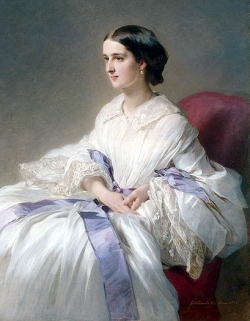 Take a clean skillet, and put in it a pint of pump water, mixed with a quarter of
a pound of starch, and keep it over a
slow fire till it is luke-warm; keep stirring it till it boils, then take it off,
and when it has stood about a minute, let it be poured into a clean earthen dish,
and covered up with a delf [glazed earthenware like Delftware] plate until it is
cold, then mix a handful of it with half as much blue, and take your muslin, spread
it out double, so as to lay the starch upon it, but don't let it be too thick. Lay
it first on the one side and then the other, but do not let it be opened out, because
it will soak through sufficiently to answer the end. Let it be laid on the finest
muslins first, and afterwards on those that are thicker, for that which is laid
upon the fine ones will serve to do the others, and most sorts of coarser cloaths
[clothes] made of muslin may be done with the same starch. When you have done starching
them, let them be laid in a clean earthen dish, and keep pressing them till the
starch begins to stick to your hands. Then wring it out of them, and when you have
wiped them with a clean dry cloth, open them out and rub gently.
Take a clean skillet, and put in it a pint of pump water, mixed with a quarter of
a pound of starch, and keep it over a
slow fire till it is luke-warm; keep stirring it till it boils, then take it off,
and when it has stood about a minute, let it be poured into a clean earthen dish,
and covered up with a delf [glazed earthenware like Delftware] plate until it is
cold, then mix a handful of it with half as much blue, and take your muslin, spread
it out double, so as to lay the starch upon it, but don't let it be too thick. Lay
it first on the one side and then the other, but do not let it be opened out, because
it will soak through sufficiently to answer the end. Let it be laid on the finest
muslins first, and afterwards on those that are thicker, for that which is laid
upon the fine ones will serve to do the others, and most sorts of coarser cloaths
[clothes] made of muslin may be done with the same starch. When you have done starching
them, let them be laid in a clean earthen dish, and keep pressing them till the
starch begins to stick to your hands. Then wring it out of them, and when you have
wiped them with a clean dry cloth, open them out and rub gently.
To clap Muslins before they are ironed
After you have opened them, rub them through your hands, and then clap them together, holding them by the ends in your hands until they are hard, but if you perceive any wet or starch upon your hands, then wash them, and keep them as dry as possible, otherwise the muslin will never look well. You must pull them with your hands both ways, which is the best method that can be used to prevent fraying, and when they are dry enough, spread them out and hold them between you and the light, by which you will see whether any of the starch remains in them. The best way to know if any of the starch remains in them, is to look through and see if any thing shines, which, if it does, it is starch, and you must rub it again with your hands. If none is left, they will fly asunder when you clap them, but they must be clapped as fast as possible, lest they become too soft and lose their colour. It is also necessary to observe that they must not be clapped singly, otherwise they will fray and tear; but always keep two or three in your hand, and the colour will be much better.
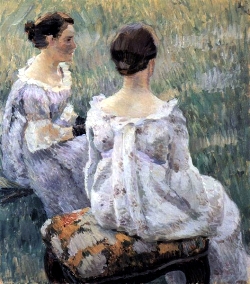 Next Mrs. Barker tells her readers "The proper Method of ironing Muslins" to avoid
fraying. Earlier she had explained how "To wash fine Muslins" using water "not too
hot lest they yellow", two lathers beaten up with a very smooth stick, some bluing
and an overnight soak. She goes on to explain how "To starch Lawns" using different
starch from the muslin mixture so as not to do the lawns "injury".
Next Mrs. Barker tells her readers "The proper Method of ironing Muslins" to avoid
fraying. Earlier she had explained how "To wash fine Muslins" using water "not too
hot lest they yellow", two lathers beaten up with a very smooth stick, some bluing
and an overnight soak. She goes on to explain how "To starch Lawns" using different
starch from the muslin mixture so as not to do the lawns "injury".
When it comes to mixing up the right starch, she lets us down a little, since she seems to feel experience is the best guide. Turning back to the page where she describes how to mix starch, we read that the quantity of starch should be what "you think proportionable to the things you have to use it for". Apart from mentioning blue and possible additives for shine, her main tip is that the more you stir, the better.
See the main History of starching page
and also:
History of Laundry: washing and drying
Ironing ruffles
Site map with full list of laundry articles
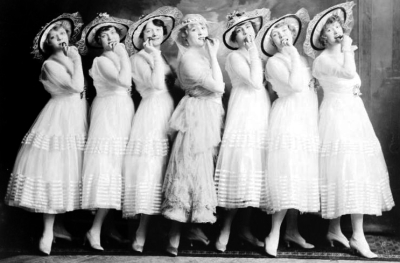
 21 July 2010
21 July 2010
You may like our new sister site Home Things Past where you'll find articles about antiques, vintage kitchen stuff, crafts, and other things to do with home life in the past. There's space for comments and discussion too. Please do take a look and add your thoughts. (Comments don't appear instantly.)
For sources please refer to the books page, and/or the excerpts quoted on the pages of this website, and note that many links lead to museum sites. Feel free to ask if you're looking for a specific reference - feedback is always welcome anyway. Unfortunately, it's not possible to help you with queries about prices or valuation.


